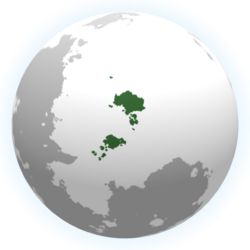User:GenderBiohazard/Sandbox 1
Republic of Cosavia | |
|---|---|
|
Flag | |
| Motto: Sample text Sample text | |
| Anthem: Sample text | |
 | |
| Capital and largest city | Sample text |
| Official languages | |
| Demonym(s) | Cosavien |
| Government | Unitary semi-presidential republic |
| Legislature | Sample text |
| Independence from Essone | |
• Declared | 1908 |
Cosavia (Essonean: Cosavie, Cosavian Creole: Kosavi), officially the Republic of Cosavia (Essonean: République de Cosavie, Cosavian Creole: Repiblik Kosavi), is an island country comprising of the Cosavian Islands off the coast of Lemaire.
History
Forster Settlement (12-13th Century)
By the 12th century, the existence of Cesylle was well known to northern Marisians. Knowledge of Halfdan the Traveler's successful expedition to Cesylle spread across areas influenced or settled by Norrsk peoples. Various subsequent expeditions were inspired by Halfdan, but these were minor and sporadic. The first notable expedition since Halfdan's came in 1146, when Serlo [de Hauteville] led a band of [Normans] to modern day Cosavia. The reasons for this expedition are varied. The [Normans] needed to find a new source of high quality timber for their ships, and reports from Druermark indicated that such timber was abundant in northern Cesylle. Historians have also proposed that Serlo, being the seventh son of a [Norman] noble, was discontent with his low place in succession and wanted to secure a fiefdom for himself. As for Serlo's followers, many were simply adventurers and fortune seekers.
Serlo's expedition set sail to Cesylle from the port of Perelle, with about [number] [Normans] on [number] ships. They made landfall on the northwestern coast of the island of Serlonie, becoming the first Cesyllans to set foot on the Cosavian islands. The settlement of Saint-Alberic was founded by Serlo at the location of his landing. He stayed there for some months until he and many of his adventurers left for the mainland. Those that remained continued to build up the settlement, and sent back word to [Normandy] of the favorable conditions for settlers in Serlonie. In the following years, a steady influx of settlers would come from [Normandy] and Esson to the Cosavian islands. Several settlements were founded along the coast. These early communities relied on fishing, forestry, and trade to sustain themselves. For their extensive logging, [Norman] settlers in Cesylle came to be known as Forsters.
The indigenous Taíno near Saint-Alberic were wary of the Forsters, and avoided contact with them. The first recorded contact was in 1154. By this time, Serlo settled in Lemaire after two successful expeditions to the mainland, and left his son Roger in charge of the Saint-Alberic settlement. Roger organized an expedition inland, encountering a village of the Merique tribe. He befriended the Merique, who traded with the Forsters and introduced the cassava to Saint-Alberic. The cassava was a staple food of the Taíno, and came to fulfill the same role among the Forsters in Cosavia. By the 1170s, trade and cooperation between the Forsters and Merique allowed them to become the dominant tribe in the area. In 1175, Roger organized a band of Forster and Taíno warriors at the Merique's request. He led them along the coast of Serlonie, looting and burning villages of the Carien tribe (a prominent rival of the Merique).
Though settlements on the northern coast of Serlonie continued to grow, Forsters struggled to establish settlements on the southern coast. The Taíno tribes here were larger and hostile to the settlers. Auvers, the prominent settlement in the southeastern bay, was raided by the Taíno and abandoned in 1174.
souþern settlements appeal to roger for help, roger helps þem in exchange for fealty, eventually founds kingdom of cosavia
